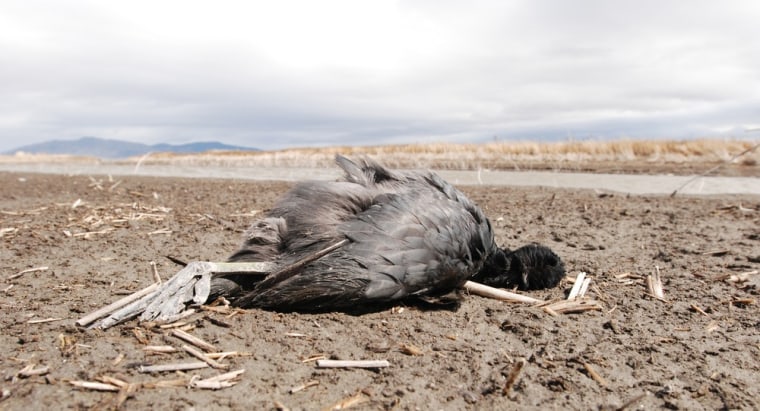Dave Mauser walked the edge of a mudflat, peering underneath the dried brown rushes where one coot after another had gone to hide and then die.
"Now the coots are getting the worst of it," said Mauser, head biologist on the Lower Klamath National Wildlife Refuge, the nation's first large marshland preserved for waterfowl habitat. "Prior to that it was the snow geese and the white-fronted geese."
Standing in line for scarce water behind both endangered fish and agriculture, Lower Klamath Lake has watched one marsh after another dry up in recent years. Now migratory geese, ducks and other waterfowl that come here by the millions, following the Pacific Flyway, are so closely packed together that an outbreak of avian cholera has killed more than 10,000 birds, mostly pintail ducks, Ross' geese, snow geese and now coots.
First reported in the United States in the 1940s, the disease is not new to the refuge. Bald eagles that congregate here in winter depend on the deadly bacteria to provide them easy food. But what is different about this year is that only half the refuge's 31,000 acres of marsh are flooded, creating perfect conditions for a broader kill off.
'Everglades of the West'
Lying on the east side of the Cascade Range along the Oregon-California border, the shallow lakes and marshes of the Upper Klamath Basin were once known as the Everglades of the West, providing a place to rest and eat for untold millions of birds on the Pacific Flyway.
More than 260 species — ruddy ducks, cinnamon teal, white-faced ibis, sandhill cranes, white pelicans, snowy egrets and bald eagles — pass through in the spring. Some stay the summer to breed, but most fly north to the Arctic to nest, returning here in the fall. Some spend the winter, and others continue south to California's Central Valley and the Salton Sea.
The historic refuge got its origins after wildlife photographer William L. Finley wrote a story for Atlantic Monthly about market hunters wiping out white egrets and grebes here for feathers to decorate ladies' hats.
President Theodore Roosevelt, an avid bird hunter and amateur taxidermist in his youth, signed the executive order creating Lower Klamath in 1908. It was the second of 55 refuges he would create, but the first to offer a large area of land for habitat.
In the 1950s the refuge would see 5 million to 7 million birds annually. Now numbers have dropped to about 2 million, primarily due to the loss of nesting habitat in the far north.
But it still "may be the most important real estate for migratory birds in North America,'" said refuge manager Ron Cole.
The problem is that it is at the end of a long line for water, legally and literally. When it comes to water in the West, first in time is first in right.
Three years earlier, in 1905, Congress created the Klamath Reclamation Project, which created a vast complex of pumps and canals that drained lakes and marshes and fed water to farmlands. The refuge started receiving water from the project in the 1940s, when a tunnel was cut to pump excess water out of Tule Lake, the end of the line for the water running through the irrigation project.
Tule Lake remained the primary source of the refuge's water until 2006, when farmers lost a subsidized electric rate that made it cheap to pump water. Now most of the water for the refuge comes from the Klamath River, through the Ady Canal.
No matter the source, the refuge does not get water until the fish and the farms are satisfied. The last full delivery was in 2006.
"It worked well for decades," said Cole, until more water had to be allocated to the river for endangered salmon, and to Upper Klamath Lake for endangered suckers.
Now it is the refuge that suffers from drought.
Incinerator takes care of dead birds
Small piles of white feathers and bones covered with dried red flesh dot the matted rushes and mudflats, all that is left after bald eagles and other predators fed on the goose carcasses. Some of the coots with their black heads and round slate-gray bodies were sprawled in the mud, unable to reach the shelter of the rushes before lying down to die. Mauser picked up a few by their wings and laid them in the back of his pickup truck.
At the refuge maintenance yard, the smell of burned flesh and feathers hung in the air. Mauser swung open the heavy door of an incinerator, placed the dead birds inside, then flipped a switch to ignite the gas.
Research indicates the disease spreads bird-to-bird, and outbreaks occur in cold months when birds are packed close together. Volunteers in airboats have picked up 3,500 dead birds and brought them to the incinerator to limit the spread of the bacteria. But with so many of the birds managing to hide before they die, most will never be found. About half the infected birds survive to spread the bacteria. Birds can die so quickly they fall out of the sky.
Summer not looking good
Record rains in March allowed the U.S. Bureau of Reclamation to start delivering all the water the refuge could take through the Ady Canal, but that will only be enough to flood 4,000 acres more before it runs out, said Cole. Prospects for this summer are not looking good.
Meanwhile, a deal that raises the refuge's water priority on a par with farms, while laying out how water is divided in drought years, has been stymied in Congress.
"Birds are hardwired to follow migratory routes they have followed since time immemorial," said Bob Sallinger, conservation director for Portland Audubon, which has joined two dozen conservation groups demanding Interior Secretary Ken Salazar assure the refuge gets the water it needs. "They are going to return to these places. The question is, will they find something when they get there."
